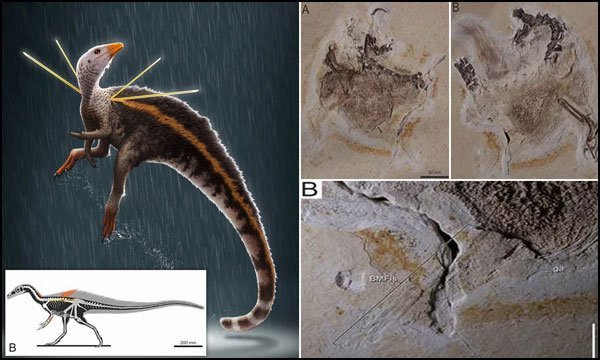Was it the "Peacock" of the Dinosaur Era?
LONDON: Scientists say there was a "bird dinosaur" 110 million years ago that may have looked like a peacock in its lifetime. However, his beak and teeth show that he was a carnivore.
According to reports, the fossils of this ancient and extinct bird with the scientific name "Ubirajara jubatus" were discovered a few years ago in an area of "karato formation" in northeastern Brazil, but they fell into the hands of smugglers. Who continued to deliver it to one country after another and to another after another.
It is not known how these fossils reached scientists and how they came to know all this, but it is certain that most of the research on "Oberjara" was done in Portsmouth, UK, while Germany And Mexican experts have also assisted in this research.
The fossils of the Obirajara Jobatus are in perfect condition, which suggests that the full length of the bird is only about a foot and a half, the size of a modern-day hen.
In addition, he had long, soft, horse-like hair all over his waist, with hard, slightly thick rod-like nucleus structures around his neck, and a thick layer of thick, thick hair on his arms. Was also Its teeth were very small but pointed.
By its very nature, the film bears a striking resemblance to a predatory dinosaur called "Velocity Raptor" shown in Jurassic Park, but scientists say it is more appropriate to call it a bird than a dinosaur. His complete body was covered with long hair.
Scientists also believe that the long, protruding nuclear structures around its neck were not intended to take part in a battle, but to enhance the beauty of the 'Obirajara'. That is, their nature was only "decorative", and nothing more
It was previously thought that modern-day birds evolved from dinosaurs, but Obirajara and other similar discoveries indicate that birds not only existed in the time of the dinosaurs but may also have evolved separately from the dinosaurs.
Although details of the discovery have been published in the latest issue of the online research journal Crete Sheis Research, a reputable research journal, there are some things that cast doubt on the discovery.
The point to note is that the whole orbit of the said discovery is based on only one fossil of 'Obirajara' as so far only one specimen of this extinct 'bird' has been discovered which, surprisingly, is in very good condition. If there is indeed any truth in this discovery, then the fossils of this bird or other similar birds must be found in the Brazilian "karato formation".
This point is also important because in the past there have been dozens of cases of the discovery of "fake fossils" which have been considered correct for years. But a careful investigation later revealed a pool of "fake forgery".
The Piltdown Man in 1912, the Nebraska Man in 1924, twelve years later, and the Archiver in 1999 are three examples of the most famous but fake "evolutionary discoveries".









No comments: